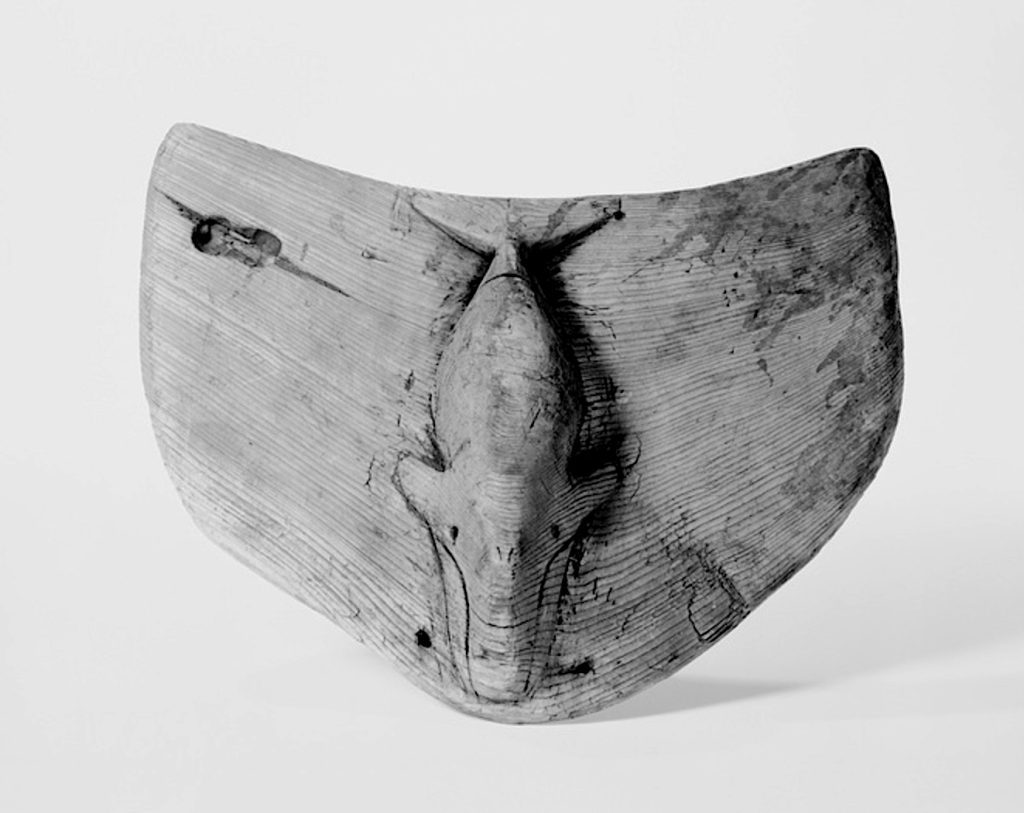Visitors to Nome, if they climb Anvil Mountain’s limestone crown on a clear day, may notice a bulge offshore 24 miles to the west. Its treeless, unassuming, volcanic square mile suggests an arctic ziggurat or an aircraft carrier turned turtle. Mirages sometimes distort it into a blue berg afloat on quicksilver waver. Debris from a Ryan Air flight litters its eastern slope. Photos rarely do it justice, and you can’t measure the wealth of this outcrop in coin.
In 1778, Captain Cook, finding a 10-foot sled with baleen lashings and bone runners “neatly put together” near decayed, semi-subterranean houses, named Sledge Island. One of Catherine the Great’s explorers later claimed the Eskimos called it Ayak, Inupiaq for “spear” or “whaling harpoon.” About 50 Ayakmiut hunted seals but also walrus migrating through the straits before they abandoned home around 1899’s gold rush. The last person born there remembered nothing about it because she’d left as a baby. Ayakmiut kept visiting until the Spanish flu’s ravages stranded them on the continent. The Smithsonian in 2011 repatriated grave goods and 19 Sledge Island skeletons it had taken. Nome’s Eskimo community welcomed these dead, which now rest at Cape Nome near an unmarked wooden cross.

Ayak was the nexus of further losses. A tug steaming to Teller six days into WWII caught fire, forcing both hands to jump overboard. Equally unlucky, in the winter of ’42, MV Crown City, supplying Nome with coal, gas, food, clothes, bulldozers, airplane components, and Quonsets, foundered in its rock-and-ice cordon. Coast dwellers salvaged machine parts and a deck load of lumber for tools and building material. Her smokestack rose from the surface until, jarred loose months later, she submarined.
Thousands of births balance the litany of death and distress. Surf laces bleached, slanted southwestern cliffs of the Alaska Maritime Wildlife Refuge, a metropolis aswirl with auklets, kittiwakes, mini-penguin murres, puffins, and cormorants, jostling, raising chicks in burrows and cracks or on ledges when not fishing in discordant frenzy. Neither foxes nor King Islanders who formerly summered on the mainland and egged here dented this population.
Sledge’s most exceptional treasure, however, as such things often do, lay hidden, forgotten.

A teacher and his class from the Inupiaq village Sinuk in 1912 sailed across for an end-of-term picnic. Students scaled the top to scan for walrus, over boulders whose lichens crinkle underfoot and that frost had riven. Descending, Johnnie Tumichuk noticed a pole wedged between those rocks. Shifting some, he recognized it as a boat crook for repelling ice and retrieving harpoon lines.
More laboring opened a cave mouth.
Inside waited a workingman Aladdin’s hoard: chert- as well as obsidian-tipped lances, a dozen; scrapers; spare slate blades sheathed in a box shaped like a polar bear head; bentwood buckets with walrus-ivory handles and whale figurines; a chest holding bear claws, an eagle’s foot, and chipped-stone amulets. A carved-bone bowhead enveloped whetstones. Two chains carved from a single unbroken tusk each, ending in flukes, hung from a harpoon rest for a skin-boat. Their craftsmanship surpassed even the sled Cook had stumbled upon. Offering glimpses of a worldview, this assemblage remains the only extant pre-contact whaling-captain outfit, an heirloom owned by a shaman who’d vanished mysteriously. Many had sought it. Johnnie’s teacher acquired the cache, which today, no longer scattered throughout University of Pennsylvania collections, resides at the Penn Museum, whole but warehoused.


In the isle’s most recent newsworthy event, a charter plane homebound from a Russian Far East church mission in 1993 plowed into three-foot swells when both engines stalled. Seven people clambered from the sinking fuselage. Clinging to empty gas cans, they expected to live 20 minutes at best in the icy chop.
Hearing the charter’s Mayday! Anchorage air traffic control alerted a Bering Air pilot in the area who thought he’d spotted a whale’s fluke though “It could have been the tail of a plane.” Circling, he then saw drifters below. Two helicopters from Nome arrived 40 minutes after impact, with body bags instead of rescue gear. Surprised helpers leaning from the birds hovering low pulled in castaways, one or two simultaneously, and shuttled them to Sledge Island. The last stayed immersed for over an hour. One woman, her coat soaked, was too heavy to be boarded. Her unfazed savior head-scissored her between his legs while the aircraft ascended. Shortly before landing she plunged from his grip, once again into misery.
All returned safely. The pilots and freestyle wrestler-guardian angel were officially honored—they’d tended to the sole Bering Sea plane crash on record with any survivors.
This backwater keeps on giving. On TV. Bering Sea Gold Argonauts crewing pontoon barges hoover gold sands from seafloor adjacent to Ayak. Its real riches lie in its layered stories. And Alaska is blessed. Scores of Sledge Islands dapple its maps.


Comments are closed.